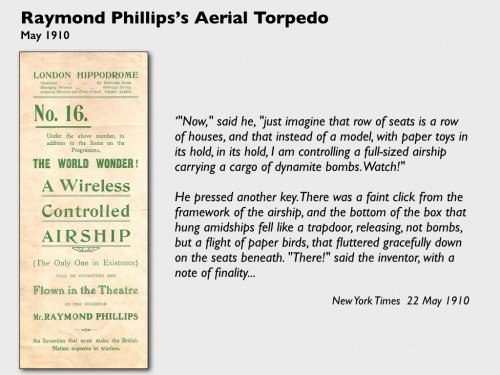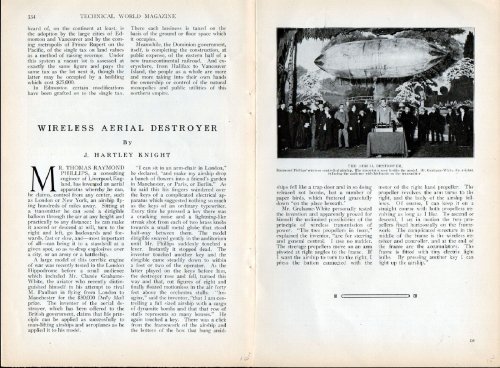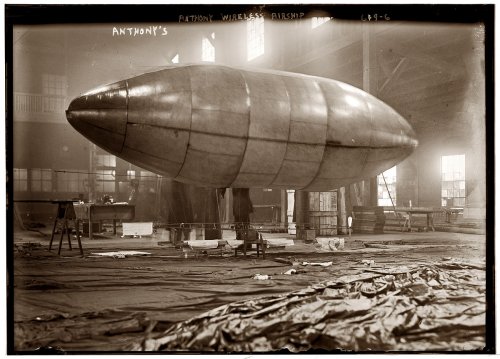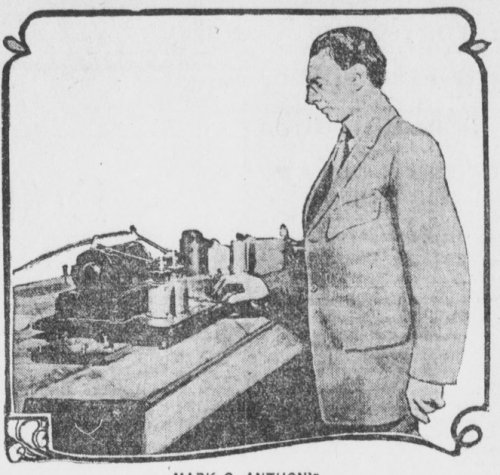W
Wingknut
Guest
Hello folks,
Hope this is not old news or wrongly placed – if so, many apologies: for all that the illustration below is an artist's impression, I decided to try this in 'Early Aircraft' (as opposed to ‘Theoretical and Speculative’) because there were at least scale-model versions of this idea tested – at the London Hippodrome theatre no less.
Raymond Philipps in 1910 demonstrated a remotely-controlled wireless guided airship – intended as the prototype for a much larger bombing flotilla. Described thus:
"Torpedoes of the Air: Bomb-Droppers Directed by Wireless", a graphical story that appeared in The Illustrated London News on 6 September 1913, and drawn by W.B. Robinson, describes a sort of two-tier remote controlled aerial bombing arrangement of dirigibles. The "parent" ship hosts a number of smaller dirigibles which are radio-controlled elements sent in to do the actual bombing, which allows for no human interaction with dropping the bombs and exposes only materiel to enemy fire. (I should point out that each one of these early drones were 40' long, making the parent dirigible something like 400' in length if we are seeing about half of it in the illustration, and enabling the thing to carry perhaps 10 of these remote controlled units. This dirigible would have been about as big as the monster Zeppelin LZ1.)
Taken from ‘Archaeology of Bombing, 1913’, JF Ptak Science Books, Post 1472, Link: http://longstreet.typepad.com/thesciencebookstore/2011/05/archaeology-of-bombing-1913.html
See also e.g. ‘Geographical Imaginations: Thomas Raymond Phillips’,
Link: http://geographicalimaginations.com/tag/thomas-raymond-phillips/
Images from: http://geographicalimaginations.com/category/bombing/
Or Brett Holman, ‘The dream of unmanned flight’, ‘Airminded’, 7 May 2011 ,
Link: http://airminded.org/2011/05/07/the-dream-of-unmanned-flight/
Cheers, 'Wingknut'
Hope this is not old news or wrongly placed – if so, many apologies: for all that the illustration below is an artist's impression, I decided to try this in 'Early Aircraft' (as opposed to ‘Theoretical and Speculative’) because there were at least scale-model versions of this idea tested – at the London Hippodrome theatre no less.
Raymond Philipps in 1910 demonstrated a remotely-controlled wireless guided airship – intended as the prototype for a much larger bombing flotilla. Described thus:
"Torpedoes of the Air: Bomb-Droppers Directed by Wireless", a graphical story that appeared in The Illustrated London News on 6 September 1913, and drawn by W.B. Robinson, describes a sort of two-tier remote controlled aerial bombing arrangement of dirigibles. The "parent" ship hosts a number of smaller dirigibles which are radio-controlled elements sent in to do the actual bombing, which allows for no human interaction with dropping the bombs and exposes only materiel to enemy fire. (I should point out that each one of these early drones were 40' long, making the parent dirigible something like 400' in length if we are seeing about half of it in the illustration, and enabling the thing to carry perhaps 10 of these remote controlled units. This dirigible would have been about as big as the monster Zeppelin LZ1.)
Taken from ‘Archaeology of Bombing, 1913’, JF Ptak Science Books, Post 1472, Link: http://longstreet.typepad.com/thesciencebookstore/2011/05/archaeology-of-bombing-1913.html
See also e.g. ‘Geographical Imaginations: Thomas Raymond Phillips’,
Link: http://geographicalimaginations.com/tag/thomas-raymond-phillips/
Images from: http://geographicalimaginations.com/category/bombing/
Or Brett Holman, ‘The dream of unmanned flight’, ‘Airminded’, 7 May 2011 ,
Link: http://airminded.org/2011/05/07/the-dream-of-unmanned-flight/
Cheers, 'Wingknut'







